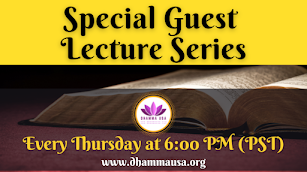Sammaditthi Sutta (MN 9) | The Path to Perfect Understanding: Summary and Paraphrase
By Bhante Sumitta
Summary
The Sammaditthi Sutta, delivered by Venerable Sāriputta at Jeta's Grove, presents a systematic exposition of right view (sammaditthi), the first factor of the Noble Eightfold Path. This discourse demonstrates how a noble disciple embodies perfect understanding through comprehensive knowledge of fundamental Buddhist doctrines.
The sutta follows a distinctive pedagogical structure where monks repeatedly inquire whether there are additional ways to understand right view, and Sāriputta responds by applying a consistent fourfold analytical framework to various doctrinal categories. This methodical approach reveals that true right view transcends mere intellectual comprehension, requiring direct insight into the nature of conditioned existence.
The discourse covers four primary domains: wholesome and unwholesome actions with their psychological roots, the four types of nutriment that sustain existence, the Four Noble Truths as the foundation of Buddhist understanding, and the twelve-link chain of dependent origination. Each category is examined through the same analytical lens: understanding what it is, how it arises, how it ceases, and the path leading to its cessation.
Throughout this systematic presentation, Sāriputta demonstrates that genuine right view involves penetrating insight into karma, craving, suffering, and the entire cycle of conditioned becoming. Each level of understanding contributes to the abandonment of mental defilements and the ultimate cessation of suffering, confirming that right view is fundamentally transformative rather than merely theoretical.
Paraphrase
In this important teaching given at Jeta's Grove, the Buddha's chief disciple Sāriputta explains to an assembly of monks what it truly means to possess right understanding, which forms the foundation of the spiritual path. The discourse unfolds through a series of questions from the monks, each asking if there are other ways to recognize someone who has achieved correct spiritual perspective.
Sāriputta's response reveals a sophisticated teaching method that examines Buddhist doctrine through multiple lenses while maintaining a consistent analytical approach. He begins by exploring the distinction between beneficial and harmful actions, explaining that ten types of unwholesome conduct—including killing, stealing, sexual misconduct, lying, harsh speech, idle chatter, divisive speech, covetousness, ill-will, and wrong view—arise from the psychological roots of greed, hatred, and delusion. Conversely, wholesome actions emerge when these toxic mental states are absent. Understanding this principle and abandoning these roots leads to the elimination of lust, aversion, and the ego-sense, thereby ending suffering.
The teaching then examines the four types of sustenance that perpetuate existence: physical food, sensory contact, mental intention, and consciousness itself. Sāriputta explains that these forms of nourishment arise through craving and cease when craving is eliminated. The Noble Eightfold Path provides the method for ending this cycle of sustenance and continued becoming.
Central to the discourse is an exposition of the Four Noble Truths: the reality of suffering, its origin in craving, the possibility of its complete cessation in nirvana, and the Eightfold Path as the method for achieving this cessation. Sāriputta emphasizes that full comprehension of these truths constitutes authentic right view and leads directly to the end of suffering.
The most extensive portion of the teaching applies this same analytical framework to each link in the twelve-fold chain of dependent origination. Beginning with aging and death and working backward through birth, becoming, clinging, craving, feeling, contact, the six sense bases, mind-body complex, consciousness, mental formations, and ignorance, Sāriputta shows how understanding each factor's nature, origin, cessation, and the path to its cessation constitutes right view.
The discourse concludes by examining the mental defilements (taints) themselves, applying the identical fourfold analysis to demonstrate how their complete understanding leads to liberation. Throughout this methodical presentation, Sāriputta illustrates that authentic right view is not passive knowledge but active insight that transforms the practitioner's relationship to existence itself.
This teaching methodology reveals that right view operates on multiple levels simultaneously—ethical, psychological, philosophical, and experiential. By repeatedly applying the same analytical framework to different aspects of Buddhist doctrine, the sutta demonstrates the interconnected nature of Buddhist understanding and shows how genuine spiritual insight penetrates every dimension of conditioned existence.
The discourse ultimately establishes that true right view involves a complete transformation of perception, where the practitioner gains direct insight into the mechanics of suffering and liberation. This understanding is not merely intellectual but represents a fundamental shift in consciousness that naturally leads to the abandonment of all defilements and the realization of ultimate freedom from suffering.





























0 comments:
Post a Comment
Your comments and feedback are very helpful to us in improving our posts. We really appreciate your time. Thank you!
Dhamma USA Team.